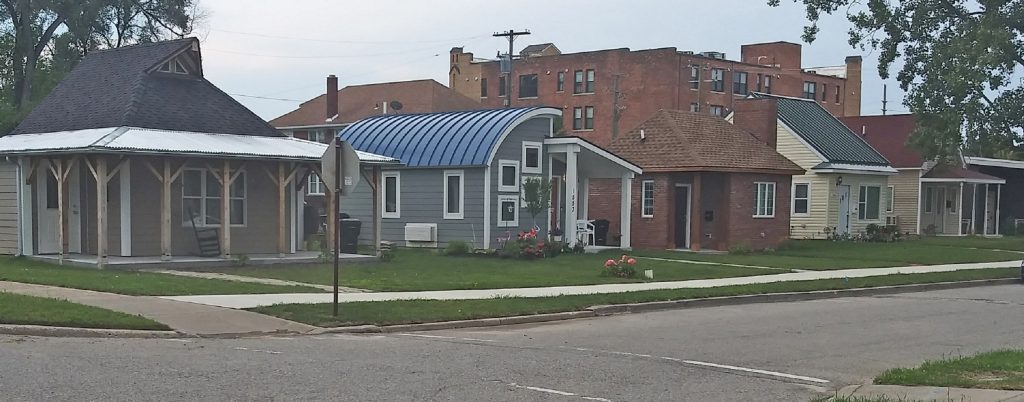
Caught in a housing crunch, Duluth, Minnesota recently changed its rules to encourage the construction of tiny homes. Until 2020, developers in Minnesota couldn’t even build houses smaller than 400 square feet. This has changed.
In multiple New England cities, too, policy makers are warming up to smaller houses. Indeed, this is happening all across the country.
The time is ripe. Tiny homes could meet housing needs for people who’ve been struggling financially, and people who just want to simplify their lives.
Minnesota Feels the Crunch. Can Its Cities Dare to Be Dense?
Duluth is a city full of older, traditional homes. But following in California’s footsteps, the city has modified its building and zoning rules. It now welcomes narrower homes and cottage home parks — parcels that accommodate small home clusters, often turned in to face each other around a park, or built near small businesses.
In Minnesota, zoning codes have, for decades, promoted large, spread-out residential development. So there can be a lack of trust around tiny homes or cottages. Some people think small homes will translate into shrinking neighborhood property values.
Yet cities are having to think about new tools. They are being pressed, for example, to create affordable workforce neighborhoods that can house veterans and people of modest incomes.
Buyers who know they want simple, small homes could look to companies such as Simply Tiny Development. The company set up shop in Duluth when the city offered incentives to developers willing to pursue innovations.
☛ Accessory dwelling units, anyone? Now, 37 Minnesota counties and cities allow backyard cottages — Duluth and the Twin Cities included.
Will Tiny Homes Be All the Rage in Amherst, New Hampshire?
A developer has a tiny home park in mind — but will the land use board greenlight the project?
The Amherst Municipal Affordable Housing Trust is considering approving the idea.
The city’s zoning regulations already allow for more than one home on a single parcel. Tiny homes could certainly work here.
☛ Building an extra unit on your land? A homeowner first has to look for applicable deed restrictions that could limit new housing units on a property.
And a new project focused on small homes could be pulled off profitably. Costs would be comparable to setting up an apartment property, as Amherst’s sewer and water utilities would be conveniently sited for the small homes.
Amherst Wouldn’t Be Alone. Dover’s Done It.
Dover, on the New Hampshire coast, already has a tiny home village. Dover has a local ordinance that enables transfers of development rights, which lets businesses pay the city for rights to create higher-than-standard density.
☛ What is the tiny house trend all about? It focuses on smaller home footprints, and embraces the philosophy of making do with less. By definition, a tiny house is a dwelling unit, other than a loft, that consists of no more than 400 square feet of floor area.
Dover’s tiny house concept is designed to be a bridge from renting to becoming a homeowner. To promote household savings, monthly rents in the village are limited to about $1,200.
The reason for that limit? It meets the standard for fair rental rates established by the federal government.
Can Tucson Lean Into the Tiny?
In Tucson, policy makers are thinking about putting tiny homes into mobile home parks. The proposed tiny homes could benefit from the utilities and infrastructure already in place, and they could replace old trailers with safer and more appealing alternatives.
Another idea the planners are considering? Putting tiny home communities into underused business park space.
Tucson has to deal with a growing unhoused population if the city fails to provide answers, and soon. To make matters even more urgent, the fastest rising segment of the population losing roofs overhead are aged 65+.
Just 12 years ago, people didn’t live in shipping containers — because the median price of a home in Tucson was $117,000,” said Tucson council member Steve Kozachik to the local TV station, 13 News.
Today, a house that cost $117K back then sells for $330K…
“And salaries have not tripled.”
That said, the tiny home trend is not just about dire affordability emergencies. There are also luxury home buyers, across the country, looking for homes that fit the minimalist lifestyle. Note that Raleigh, North Carolina is getting its first luxury tiny home village. Early residents will be renters, but there’s a plan in place to offer them equity in their homes.
Survey Says: New Homes Are Getting Smaller

The developer D.R. Horton observes that the square footage of homes purchased today is just over 2,000. That’s down 2% year-over-year, reports Yahoo Finance reporter Dani Romero.
The company says the reason for the trend is clear. It’s meeting the needs of the market and responding to rising mortgage interest rates. It also addresses inflation, and the way material costs are adding up per foot of floor space. Now, builders are designing homes with simpler features and fewer windows.
Builders can’t sell homes to new generations of buyers if the homes they’re building don’t take into account renters’ current financial situations. But these companies have a ready advantage. They do have the ability to build smaller, and thereby outmaneuver sellers of existing homes.
Builders, and mortgage companies too, are finding other ways to entice renters to apply for mortgages. They’ve been offering incentives to buyers for inflationary times — including mortgage interest rate buydowns.
☛ Read more on Deeds.com on how mortgage companies are offering new deals for home buyers struggling with inflation.
Bet Your Bottom Dollar: The House of the Future Is Smaller
On top of the housing price surges nationwide, a string of federal interest rate hikes has rippled out into the home loan market, making monthly mortgage costs steeper than they have been for many years.
☛ Why is it getting so hard to afford financing these days? Here’s what the Federal Reserve is doing with interest rates, and why home buyers need to know.
Still, throughout the generations of working people, many just can’t afford mortgages at this time. Something has to be done.
Tiny homes aren’t a cure-all. But they can put roofs over a lot of heads. So we can bet on them, and the role a small-home movement has to play — today, and in the future.
Supporting References
Dan Kraker for MPR News (Minnesota Public Radio): Housing – Duluth Looks to “Tiny Homes” to Help Ease Housing Crunch (Dec. 6, 2022).
Scott Merzbach for the Daily Hampshire Gazette (Northampton, MA), via GazetteNet.com: Affordable Housing Advocates in Amherst Learn About Tiny-House Potential, Approve Housing Coordinator Job (Apr. 17, 2023).
Dani Romero for Yahoo Finance: Homebuilders Churn Out Smaller Homes to Attract First-Time Buyers (Jul. 25, 2023; citing data from John Burns Research & Consulting).
Bud Foster for 13 News via KOLD.com: Tucson to Change Zoning and Building Codes to Accommodate Tiny Homes and Tiny Home Villages (Aug. 5, 2023).
And as linked.
More on topics: Affordable housing, Residential zoning.
Photo credits: Tiny Homes Detroit, from Cass Community Social Services. Andrew Jameson via Wikimedia Commons, licensed under CC BY-SA 4.0 International license; and Melike Benli, via Pexels.
